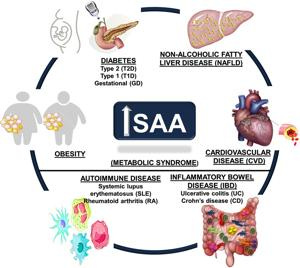What Role Does Amyloid Have in Disease Pathogenesis in the Human Body?
Reading & Commentary June 2nd 2025
Can TUDCA, DMSO or Methylene Blue help to mitigate amyloid related diseases?
What is Amyloid?
Amyloid refers to aggregates of proteins that form insoluble, fibrillar structures characterized by a beta-pleated sheet secondary structure. These fibrils typically have a diameter of 7–13 nm and can be identified in tissue samples by their unique staining properties, such as apple-green birefringence under polarized light when stained with Congo red54. Amyloids can be formed from a variety of different proteins, each associated with specific diseases5.
Role of Amyloid in Disease Pathogenesis
Amyloid's role in disease stems from the abnormal folding and aggregation of normally soluble proteins. When these proteins misfold, they lose their normal function and aggregate into amyloid fibrils, which deposit within or around cells in tissues and organs. This deposition disrupts normal tissue architecture and function, leading to a group of disorders collectively known as amyloidoses5178.
Mechanisms of Pathogenesis
Protein Misfolding: Amyloid diseases are protein misfolding disorders. Normally soluble proteins adopt abnormal conformations, aggregate, and form insoluble fibrils53.
Tissue Disruption: The accumulation of amyloid fibrils in tissues and organs (such as the heart, kidneys, liver, spleen, nervous system, and digestive tract) impairs their normal function, often leading to organ failure17.
Cellular Toxicity: In some neurodegenerative diseases, amyloid oligomers and fibrils are believed to be directly toxic to cells, contributing to neuronal death and tissue degeneration236.
Diseases Associated with Amyloid
Amyloid deposition is implicated in over 50 human diseases, including:
Alzheimer’s disease: Accumulation of amyloid-beta (Aβ) peptides in the brain forms plaques that are a hallmark of the disease and are associated with progressive cognitive decline3456.
Parkinson’s disease: Aggregation of alpha-synuclein into amyloid fibrils35.
Type 2 diabetes: Deposition of islet amyloid polypeptide (amylin) in the pancreas35.
Systemic amyloidoses: Such as light chain (AL) amyloidosis and serum amyloid A (AA) amyloidosis, affecting multiple organs357.
Prion diseases: Infectious amyloid forms of the prion protein cause transmissible spongiform encephalopathies35.
Functional Amyloids
Not all amyloids are pathogenic. Some functional amyloids have beneficial roles in physiological processes, such as long-term memory formation and hormone storage and release4.
Summary Table: Amyloid and Disease
Amyloid ProteinAssociated Disease(s)Pathogenic RoleAmyloid-beta (Aβ)Alzheimer’s diseaseBrain plaques, neurodegenerationAlpha-synucleinParkinson’s diseaseLewy bodies, neuronal toxicityIslet amyloid polypeptide (amylin)Type 2 diabetesPancreatic deposits, beta-cell lossTransthyretin (TTR)Familial amyloid polyneuropathy, cardiomyopathySystemic organ dysfunctionImmunoglobulin light chainsAL amyloidosisMulti-organ amyloid depositionSerum amyloid AAA amyloidosisKidney, liver dysfunction
Conclusion
Amyloid is a misfolded protein aggregate with a distinct fibrillar structure. Its pathological accumulation disrupts tissue and organ function, playing a central role in the pathogenesis of many serious human diseases, especially neurodegenerative and systemic disorders1357.
Can TUDCA, DMSO, or Methylene Blue Help Mitigate Amyloid-Related Diseases?
TUDCA (Tauroursodeoxycholic Acid)
TUDCA has shown significant promise in preclinical models for mitigating amyloid-related diseases, especially Alzheimer’s disease and cardiac amyloidosis:
In mouse models of Alzheimer’s, TUDCA reduces amyloid-beta (Aβ) deposition in the brain, ameliorates memory deficits, decreases glial activation, and preserves neuronal integrity358. It appears to interfere with amyloid precursor protein processing, likely through modulation of γ-secretase activity and regulation of lipid metabolism mediators35.
TUDCA also reduces neuroinflammation, oxidative stress, and endoplasmic reticulum (ER) stress, all of which are implicated in amyloid toxicity65.
In animal models of transthyretin (TTR) cardiac amyloidosis, TUDCA—especially when combined with doxycycline—slows disease progression and reduces tissue amyloid burden4.
Human data are limited, but TUDCA is considered safe and well-tolerated in clinical trials for other neurodegenerative diseases, and ongoing research is evaluating its efficacy in amyloid-related conditions75.
Conclusion:
TUDCA shows the most promise for mitigating amyloid-related diseases based on current preclinical evidence, with ongoing research in humans. There is no substantial evidence supporting the use of DMSO or methylene blue for this purpose in the context of amyloid diseases345678.






